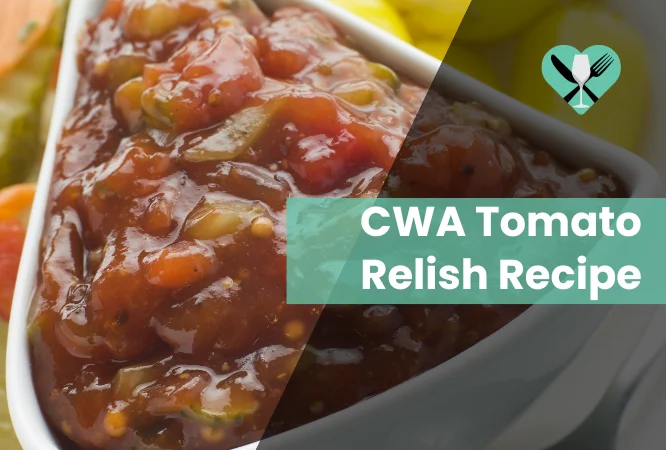There’s something wonderfully old-fashioned and satisfying about opening a jar of homemade tomato relish. It’s not just about the taste — though that sweet, spicy tang certainly hits the spot — but about the memories wrapped up in every spoonful.
For many Australians, particularly those raised in the country or lucky enough to have known their nan’s kitchen well, tomato relish is part of the family fabric. It’s what you slathered onto a sausage in bread at every footy fundraiser. It’s what made a simple cheese sandwich taste like a little luxury. And most importantly, it’s what was made with care — slowly simmered on the stove, labelled with a biro on masking tape, and tucked neatly into the pantry for the year ahead.
Today, we’re diving into a beloved homemade CWA tomato relish recipe in the spirit of the Country Women’s Association — one that’s simple, reliable, and timeless.
Tomato Relish: More Than Just a Condiment
Tomato relish is a bit like that dependable friend who never lets you down. It jazzes up a meal, adds zing to plain food, and often saves the day when you’ve got “nothing in the house” — because a good jar of relish can turn toast, leftovers, or boiled eggs into something satisfying.
But this is more than just pantry filler. It’s a little act of love, passed on through generations. Every jar speaks of patient stirring, homegrown tomatoes, and the quiet magic of taking simple ingredients and making something special.
I remember one year, our neighbour Mrs. Winifred brought over three jars as a Christmas gift — all neatly wrapped in reused fabric with cotton string. “Made with my last summer tomatoes,” she said, with a wink. That relish stretched far into winter, and every time I opened the jar, I could almost feel the sunshine of her back garden.
Ingredients – What You’ll Need to Make CWA Tomato Relish Recipe
No frills. Just pantry staples and garden goodness.
- 2.5 kg ripe tomatoes – roughly chopped
- 500g brown onions – finely sliced
- 2 tbsp cooking salt (sea salt or kosher)
- 500g white or raw sugar
- 2 cups malt vinegar (or white vinegar if you prefer a sharper finish)
- 1 tbsp mustard powder
- 1 tbsp curry powder
- 1 tsp ground cloves
- 1 tsp ground black pepper
- ¼ cup plain flour (for thickening)
- ½ cup extra vinegar (to mix with flour)
Step-by-Step Method – No Need to Rush
1. Salt and Sit
Put the tomatoes and onions into a large bowl, sprinkle over the salt, mix gently, cover, and let it rest overnight. This step helps draw out the moisture and brings out the natural sweetness in the tomatoes.
Many older cooks will tell you not to skip this step. “It’s what makes the flavours round and mellow,” my aunty June always said.
2. Into the Pot
Next day, drain off the liquid and transfer everything into a large heavy-based saucepan. Add sugar and vinegar. Bring it up to a gentle simmer, then reduce heat and cook for about 1½ to 2 hours, stirring occasionally.
Let it thicken naturally. This part can’t be hurried. Put the kettle on, play the radio, and enjoy the aroma filling your home. It’s a true ‘slow food’ moment.
3. Add Your Spice
When the mixture has thickened and reduced, add in the mustard, curry powder, cloves, and pepper. Cook for another 10–15 minutes to allow the spices to mellow and blend through.
4. Thicken the Mix
In a small bowl, mix the flour with the extra ½ cup of vinegar to make a paste. Stir it into the pot and let it simmer another 10–15 minutes until it reaches that perfect ‘coat-the-spoon’ texture.
Preserving and Bottling – A Simple Tradition
Sterilise your jars in a low oven (about 120°C for 15–20 minutes) while the relish finishes cooking.
While the relish is still hot, spoon it into the warm jars. Wipe the rims, seal with clean lids, and let them cool on a folded tea towel. Once cooled, store in a cool, dark cupboard.
Label each jar with the date — and perhaps a note if you’ve given it your own twist. My cousin used to write “extra spicy!” or “best batch yet!” and I still smile reading those today.
How to Use It – Our Favourite Ways
CWA Tomato Relish isn’t just for toasties (though it’s fabulous in one). Here’s how our family loves to enjoy it:
1. Ploughman’s Platter
A crusty roll, a wedge of cheddar, some sliced apple, and a good spoonful of relish. Lunch, sorted.
2. On BBQ Snags
Forget store-bought sauce — a dollop of this on grilled sausages is the real deal.
3. In Burgers
Spread it under your patty, or even stir some into mayo for a zesty twist.
4. With Quiche or Frittata
It’s a lovely partner to eggy dishes — cuts through the richness beautifully.
5. Stirred into Pasta Sauce
Sounds strange, but a spoonful in your spaghetti sauce adds a lovely depth of flavour.
A Story From Nan’s Kitchen
The grandmother of one of my friends never measured anything, but her tomato relish was always perfect. She’d stand by her old enamel stove, apron dusted in flour from the scones she’d made earlier, and stir with a wooden spoon worn smooth from years of use.
“Watch for the shine,” she’d say, holding up the spoon, “You want it glossy — not too runny, not too sticky. Just right.”
Every winter, she’d gift each of her relatives a small jar, tied with ribbon. She didn’t realise how special that was until she passed, and the last jar sat unopened for months. She finally had it with some cold roast chicken on a sandwich, and cried right there in the kitchen.
That’s the thing about recipes like this. They don’t just feed the belly — they feed the soul.
Can I Tweak the Recipe?
Absolutely. Think of this tomato relish recipe as your base, your canvas. Here are a few ways you can make it your own:
- Add chillies or chilli flakes for heat.
- Use apple cider vinegar for a softer tang.
- Add some grated apple for extra sweetness.
- Try heirloom tomatoes for a mix of colours and flavour.
As long as the sugar and vinegar proportions stay safe for preserving, you’ve got room to experiment.
Frequently Asked Questions (FAQs)
How long does a CWA-style tomato relish recipe last?
Unopened and stored in a cool spot, up to a year. Once opened, keep it in the fridge and use within 6–8 weeks.
Can I use canned tomatoes?
Fresh is best, but if you’re in a pinch, good-quality canned tomatoes will work. Just drain off any extra liquid before cooking.
Why use flour instead of cornflour?
Plain flour gives a more traditional, hearty consistency. Cornflour can turn a bit jelly-like if not handled carefully.
In Closing – A Recipe Worth Passing Down
CWA-style tomato relish isn’t just a recipe. It’s a little slice of history, a simple act of love, and a delicious way to honour the past while brightening today’s meals.
There’s something so grounding about making your own preserves — the rhythm of chopping, stirring, pouring, labelling. It’s slow living in a jar. And whether you’re giving it as a gift or keeping it all to yourself, one thing’s for sure: once you start making this, you’ll wonder how you ever lived without it.
So go on — grab those tomatoes, dust off your apron, and get that pot simmering. Your future self (and your sandwich) will thank you.






